University Financial Analysis and Audit Risk Report for TFW (3102AFE)
VerifiedAdded on 2023/04/21
|11
|2381
|105
Report
AI Summary
This report presents a financial analysis of Top Fashion Warehouse Ltd (TFW), conducted through ratio analysis, examining liquidity, activity, profitability, and solvency. The analysis identifies inherent risks like changes in cash and inventory, as well as macroeconomic and business factor risks. Four key accounts are scrutinized: liquidity position, debt and asset position, inventory turnover, and inventory level, highlighting associated risks. The report also assesses key assertions related to cash, plant and machinery, interest-bearing liabilities, and inventory, emphasizing potential misstatements and the need for auditor verification. The conclusion summarizes the findings, emphasizing the identified risks and the importance of careful financial scrutiny. The assignment was based on the 3102AFE Client Analysis Case Study Trimester 3, 2018 assignment brief, and the student has provided a comprehensive analysis of the company's financial health.
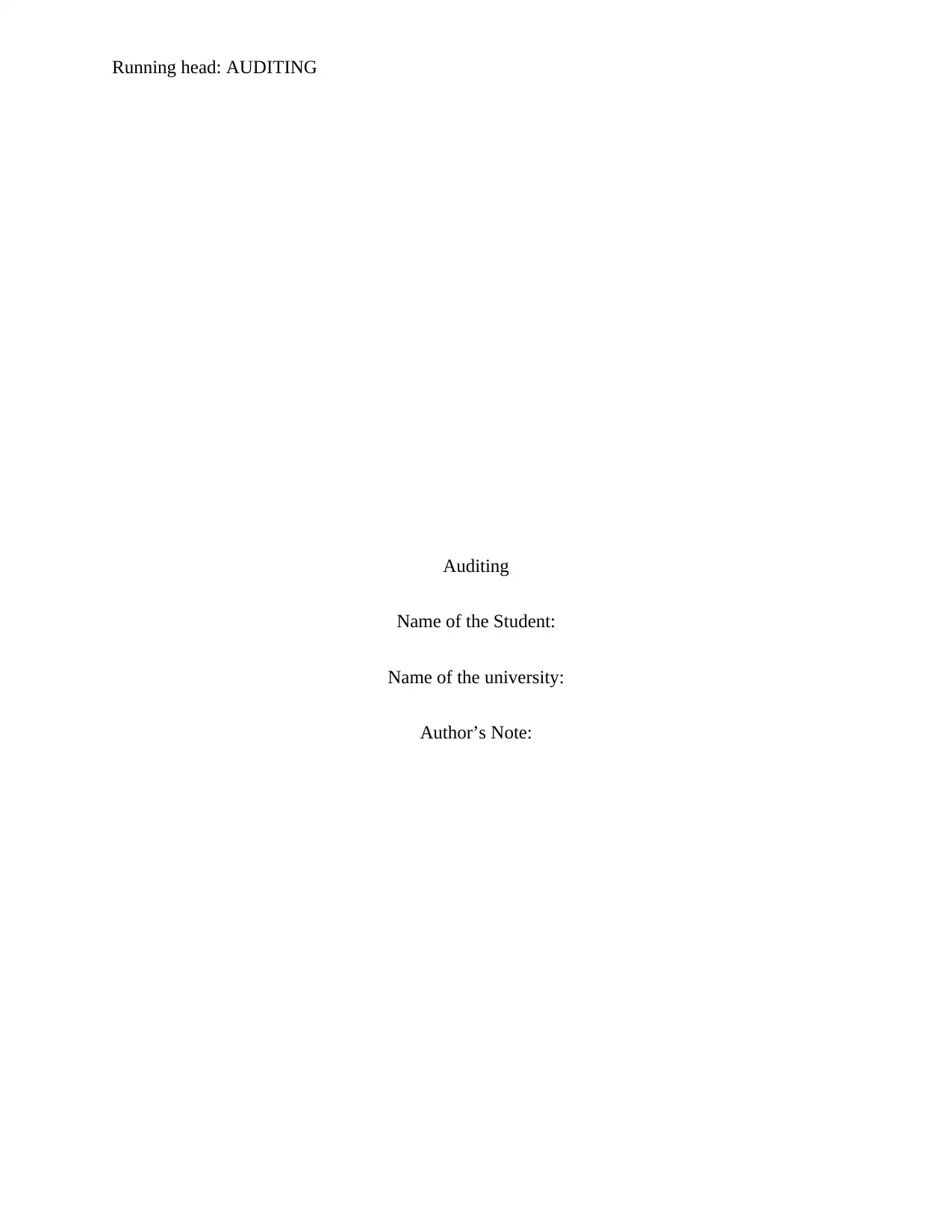
Running head: AUDITING
Auditing
Name of the Student:
Name of the university:
Author’s Note:
Auditing
Name of the Student:
Name of the university:
Author’s Note:
Secure Best Marks with AI Grader
Need help grading? Try our AI Grader for instant feedback on your assignments.
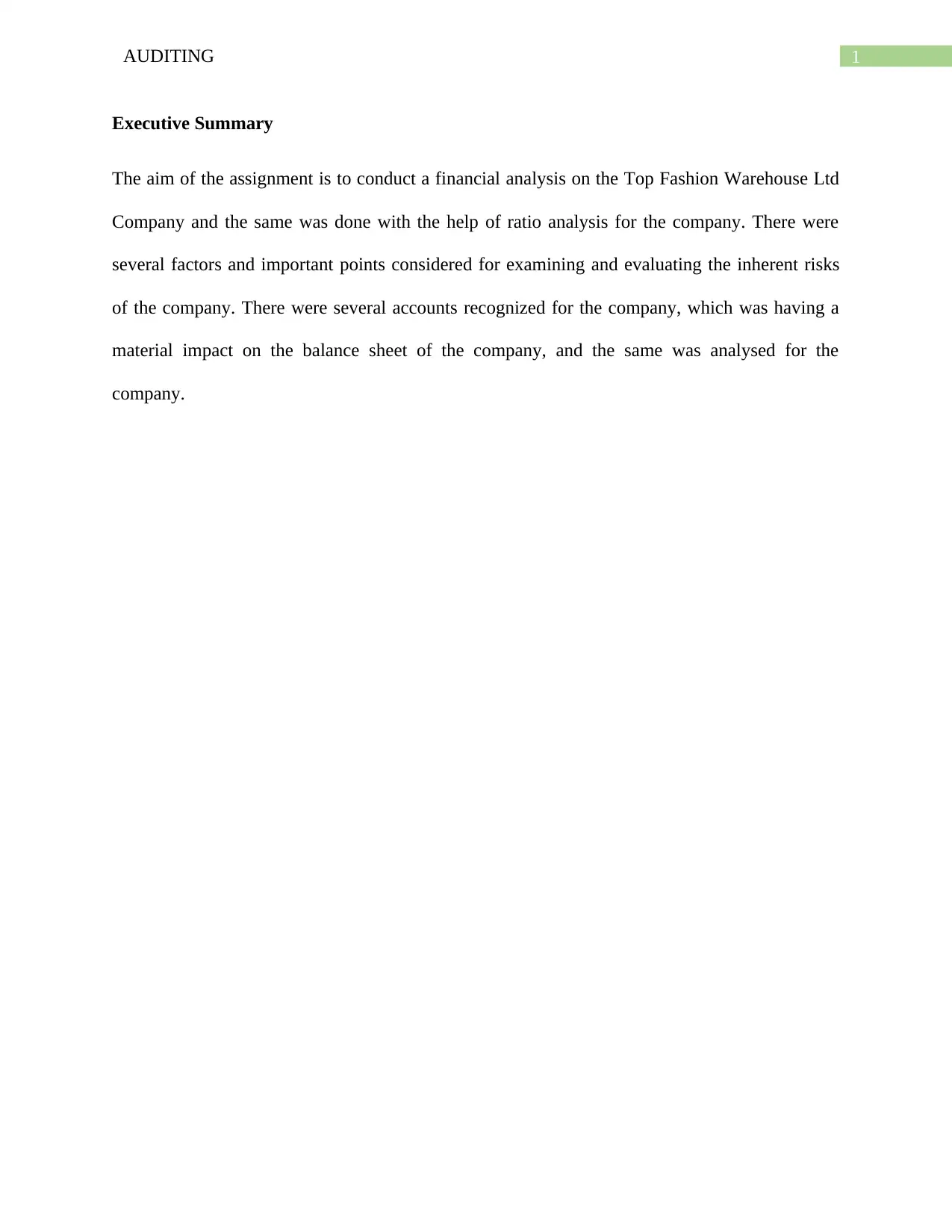
1AUDITING
Executive Summary
The aim of the assignment is to conduct a financial analysis on the Top Fashion Warehouse Ltd
Company and the same was done with the help of ratio analysis for the company. There were
several factors and important points considered for examining and evaluating the inherent risks
of the company. There were several accounts recognized for the company, which was having a
material impact on the balance sheet of the company, and the same was analysed for the
company.
Executive Summary
The aim of the assignment is to conduct a financial analysis on the Top Fashion Warehouse Ltd
Company and the same was done with the help of ratio analysis for the company. There were
several factors and important points considered for examining and evaluating the inherent risks
of the company. There were several accounts recognized for the company, which was having a
material impact on the balance sheet of the company, and the same was analysed for the
company.
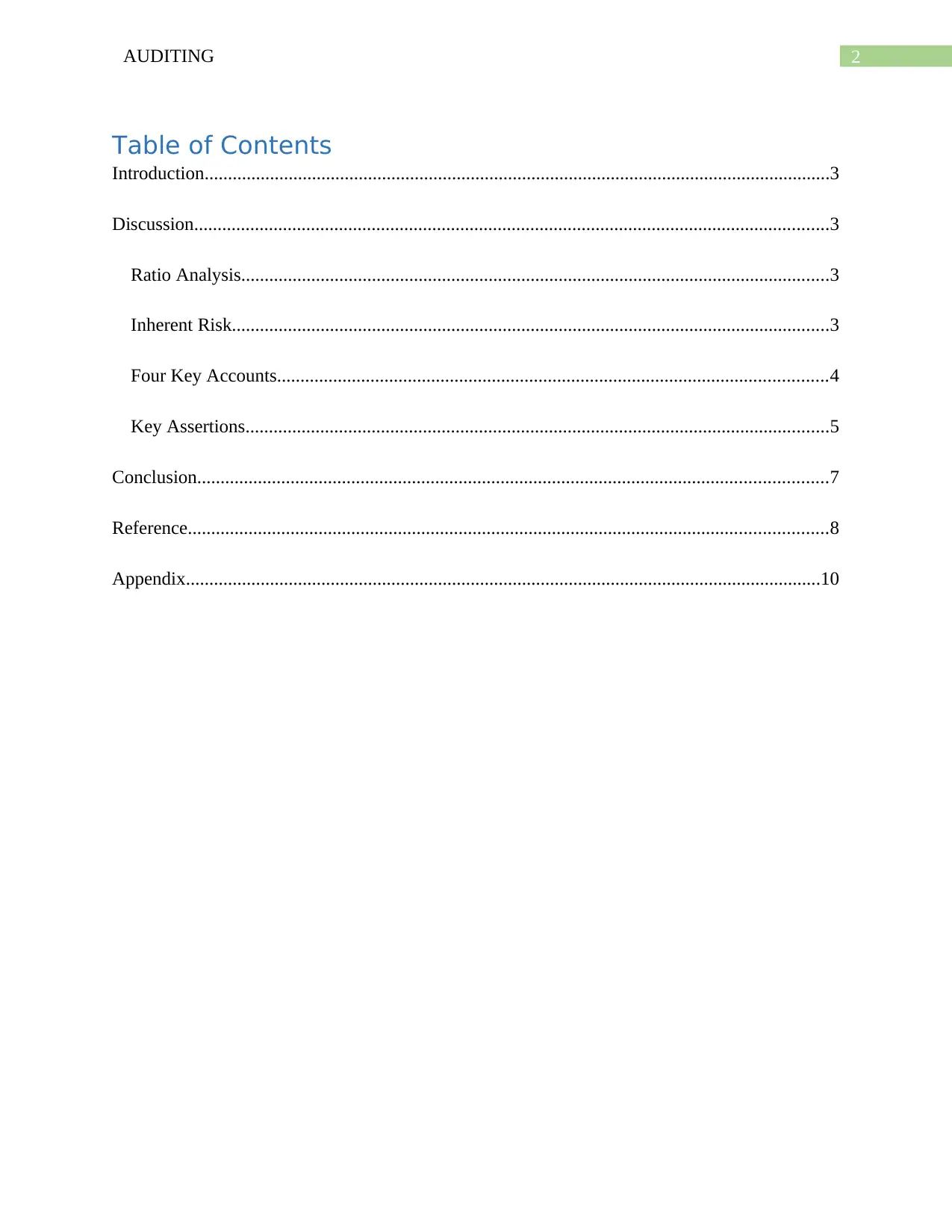
2AUDITING
Table of Contents
Introduction......................................................................................................................................3
Discussion........................................................................................................................................3
Ratio Analysis..............................................................................................................................3
Inherent Risk................................................................................................................................3
Four Key Accounts......................................................................................................................4
Key Assertions.............................................................................................................................5
Conclusion.......................................................................................................................................7
Reference.........................................................................................................................................8
Appendix........................................................................................................................................10
Table of Contents
Introduction......................................................................................................................................3
Discussion........................................................................................................................................3
Ratio Analysis..............................................................................................................................3
Inherent Risk................................................................................................................................3
Four Key Accounts......................................................................................................................4
Key Assertions.............................................................................................................................5
Conclusion.......................................................................................................................................7
Reference.........................................................................................................................................8
Appendix........................................................................................................................................10
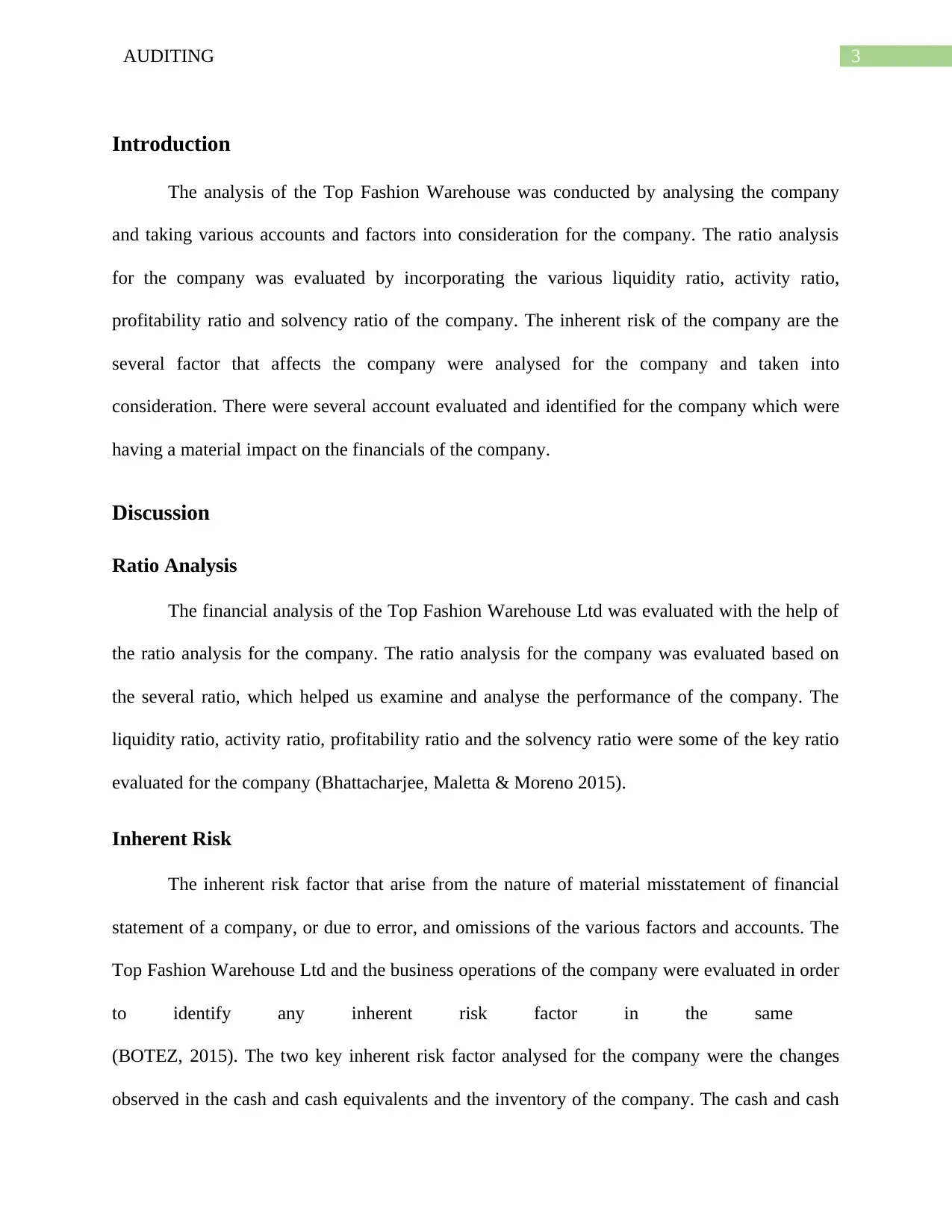
3AUDITING
Introduction
The analysis of the Top Fashion Warehouse was conducted by analysing the company
and taking various accounts and factors into consideration for the company. The ratio analysis
for the company was evaluated by incorporating the various liquidity ratio, activity ratio,
profitability ratio and solvency ratio of the company. The inherent risk of the company are the
several factor that affects the company were analysed for the company and taken into
consideration. There were several account evaluated and identified for the company which were
having a material impact on the financials of the company.
Discussion
Ratio Analysis
The financial analysis of the Top Fashion Warehouse Ltd was evaluated with the help of
the ratio analysis for the company. The ratio analysis for the company was evaluated based on
the several ratio, which helped us examine and analyse the performance of the company. The
liquidity ratio, activity ratio, profitability ratio and the solvency ratio were some of the key ratio
evaluated for the company (Bhattacharjee, Maletta & Moreno 2015).
Inherent Risk
The inherent risk factor that arise from the nature of material misstatement of financial
statement of a company, or due to error, and omissions of the various factors and accounts. The
Top Fashion Warehouse Ltd and the business operations of the company were evaluated in order
to identify any inherent risk factor in the same
(BOTEZ, 2015). The two key inherent risk factor analysed for the company were the changes
observed in the cash and cash equivalents and the inventory of the company. The cash and cash
Introduction
The analysis of the Top Fashion Warehouse was conducted by analysing the company
and taking various accounts and factors into consideration for the company. The ratio analysis
for the company was evaluated by incorporating the various liquidity ratio, activity ratio,
profitability ratio and solvency ratio of the company. The inherent risk of the company are the
several factor that affects the company were analysed for the company and taken into
consideration. There were several account evaluated and identified for the company which were
having a material impact on the financials of the company.
Discussion
Ratio Analysis
The financial analysis of the Top Fashion Warehouse Ltd was evaluated with the help of
the ratio analysis for the company. The ratio analysis for the company was evaluated based on
the several ratio, which helped us examine and analyse the performance of the company. The
liquidity ratio, activity ratio, profitability ratio and the solvency ratio were some of the key ratio
evaluated for the company (Bhattacharjee, Maletta & Moreno 2015).
Inherent Risk
The inherent risk factor that arise from the nature of material misstatement of financial
statement of a company, or due to error, and omissions of the various factors and accounts. The
Top Fashion Warehouse Ltd and the business operations of the company were evaluated in order
to identify any inherent risk factor in the same
(BOTEZ, 2015). The two key inherent risk factor analysed for the company were the changes
observed in the cash and cash equivalents and the inventory of the company. The cash and cash
Secure Best Marks with AI Grader
Need help grading? Try our AI Grader for instant feedback on your assignments.
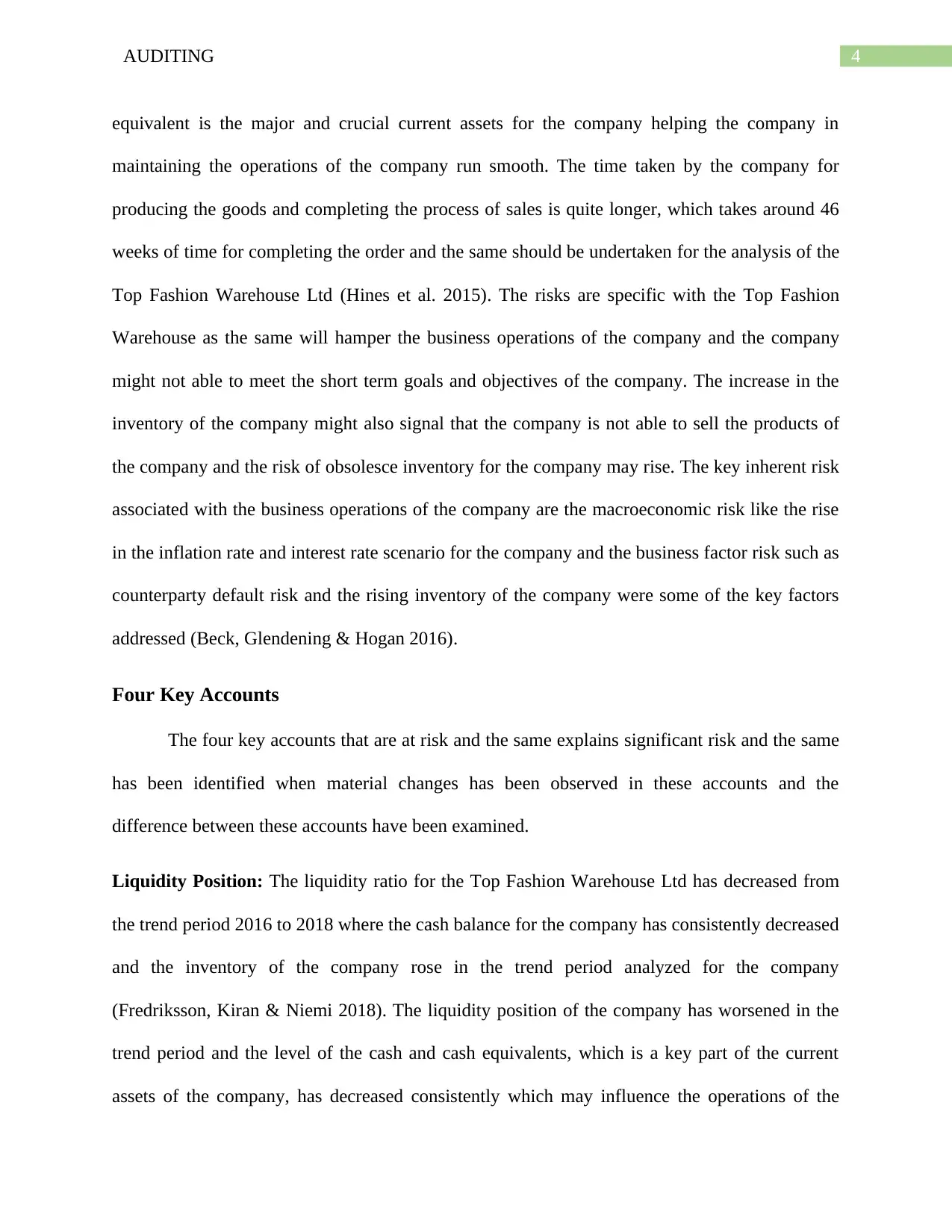
4AUDITING
equivalent is the major and crucial current assets for the company helping the company in
maintaining the operations of the company run smooth. The time taken by the company for
producing the goods and completing the process of sales is quite longer, which takes around 46
weeks of time for completing the order and the same should be undertaken for the analysis of the
Top Fashion Warehouse Ltd (Hines et al. 2015). The risks are specific with the Top Fashion
Warehouse as the same will hamper the business operations of the company and the company
might not able to meet the short term goals and objectives of the company. The increase in the
inventory of the company might also signal that the company is not able to sell the products of
the company and the risk of obsolesce inventory for the company may rise. The key inherent risk
associated with the business operations of the company are the macroeconomic risk like the rise
in the inflation rate and interest rate scenario for the company and the business factor risk such as
counterparty default risk and the rising inventory of the company were some of the key factors
addressed (Beck, Glendening & Hogan 2016).
Four Key Accounts
The four key accounts that are at risk and the same explains significant risk and the same
has been identified when material changes has been observed in these accounts and the
difference between these accounts have been examined.
Liquidity Position: The liquidity ratio for the Top Fashion Warehouse Ltd has decreased from
the trend period 2016 to 2018 where the cash balance for the company has consistently decreased
and the inventory of the company rose in the trend period analyzed for the company
(Fredriksson, Kiran & Niemi 2018). The liquidity position of the company has worsened in the
trend period and the level of the cash and cash equivalents, which is a key part of the current
assets of the company, has decreased consistently which may influence the operations of the
equivalent is the major and crucial current assets for the company helping the company in
maintaining the operations of the company run smooth. The time taken by the company for
producing the goods and completing the process of sales is quite longer, which takes around 46
weeks of time for completing the order and the same should be undertaken for the analysis of the
Top Fashion Warehouse Ltd (Hines et al. 2015). The risks are specific with the Top Fashion
Warehouse as the same will hamper the business operations of the company and the company
might not able to meet the short term goals and objectives of the company. The increase in the
inventory of the company might also signal that the company is not able to sell the products of
the company and the risk of obsolesce inventory for the company may rise. The key inherent risk
associated with the business operations of the company are the macroeconomic risk like the rise
in the inflation rate and interest rate scenario for the company and the business factor risk such as
counterparty default risk and the rising inventory of the company were some of the key factors
addressed (Beck, Glendening & Hogan 2016).
Four Key Accounts
The four key accounts that are at risk and the same explains significant risk and the same
has been identified when material changes has been observed in these accounts and the
difference between these accounts have been examined.
Liquidity Position: The liquidity ratio for the Top Fashion Warehouse Ltd has decreased from
the trend period 2016 to 2018 where the cash balance for the company has consistently decreased
and the inventory of the company rose in the trend period analyzed for the company
(Fredriksson, Kiran & Niemi 2018). The liquidity position of the company has worsened in the
trend period and the level of the cash and cash equivalents, which is a key part of the current
assets of the company, has decreased consistently which may influence the operations of the
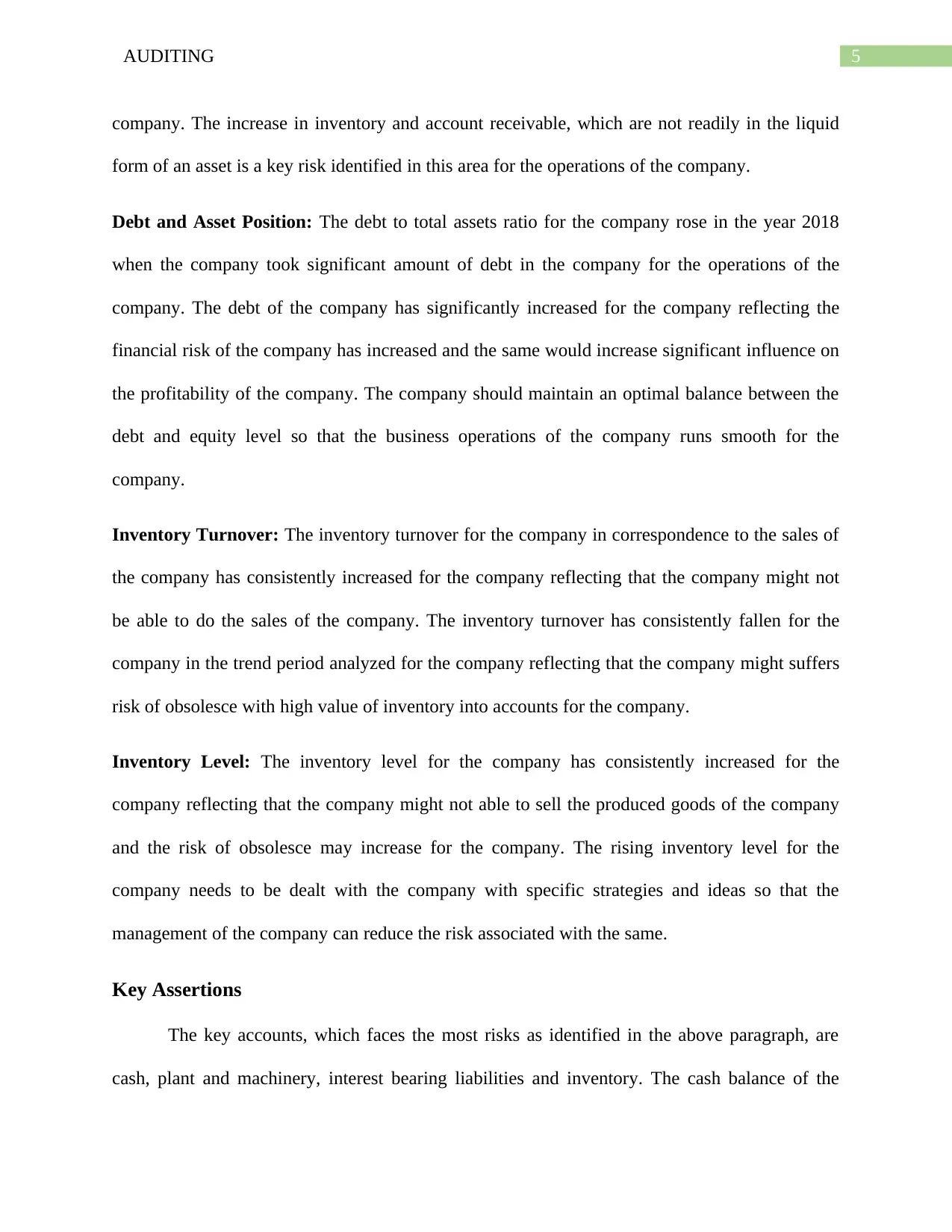
5AUDITING
company. The increase in inventory and account receivable, which are not readily in the liquid
form of an asset is a key risk identified in this area for the operations of the company.
Debt and Asset Position: The debt to total assets ratio for the company rose in the year 2018
when the company took significant amount of debt in the company for the operations of the
company. The debt of the company has significantly increased for the company reflecting the
financial risk of the company has increased and the same would increase significant influence on
the profitability of the company. The company should maintain an optimal balance between the
debt and equity level so that the business operations of the company runs smooth for the
company.
Inventory Turnover: The inventory turnover for the company in correspondence to the sales of
the company has consistently increased for the company reflecting that the company might not
be able to do the sales of the company. The inventory turnover has consistently fallen for the
company in the trend period analyzed for the company reflecting that the company might suffers
risk of obsolesce with high value of inventory into accounts for the company.
Inventory Level: The inventory level for the company has consistently increased for the
company reflecting that the company might not able to sell the produced goods of the company
and the risk of obsolesce may increase for the company. The rising inventory level for the
company needs to be dealt with the company with specific strategies and ideas so that the
management of the company can reduce the risk associated with the same.
Key Assertions
The key accounts, which faces the most risks as identified in the above paragraph, are
cash, plant and machinery, interest bearing liabilities and inventory. The cash balance of the
company. The increase in inventory and account receivable, which are not readily in the liquid
form of an asset is a key risk identified in this area for the operations of the company.
Debt and Asset Position: The debt to total assets ratio for the company rose in the year 2018
when the company took significant amount of debt in the company for the operations of the
company. The debt of the company has significantly increased for the company reflecting the
financial risk of the company has increased and the same would increase significant influence on
the profitability of the company. The company should maintain an optimal balance between the
debt and equity level so that the business operations of the company runs smooth for the
company.
Inventory Turnover: The inventory turnover for the company in correspondence to the sales of
the company has consistently increased for the company reflecting that the company might not
be able to do the sales of the company. The inventory turnover has consistently fallen for the
company in the trend period analyzed for the company reflecting that the company might suffers
risk of obsolesce with high value of inventory into accounts for the company.
Inventory Level: The inventory level for the company has consistently increased for the
company reflecting that the company might not able to sell the produced goods of the company
and the risk of obsolesce may increase for the company. The rising inventory level for the
company needs to be dealt with the company with specific strategies and ideas so that the
management of the company can reduce the risk associated with the same.
Key Assertions
The key accounts, which faces the most risks as identified in the above paragraph, are
cash, plant and machinery, interest bearing liabilities and inventory. The cash balance of the
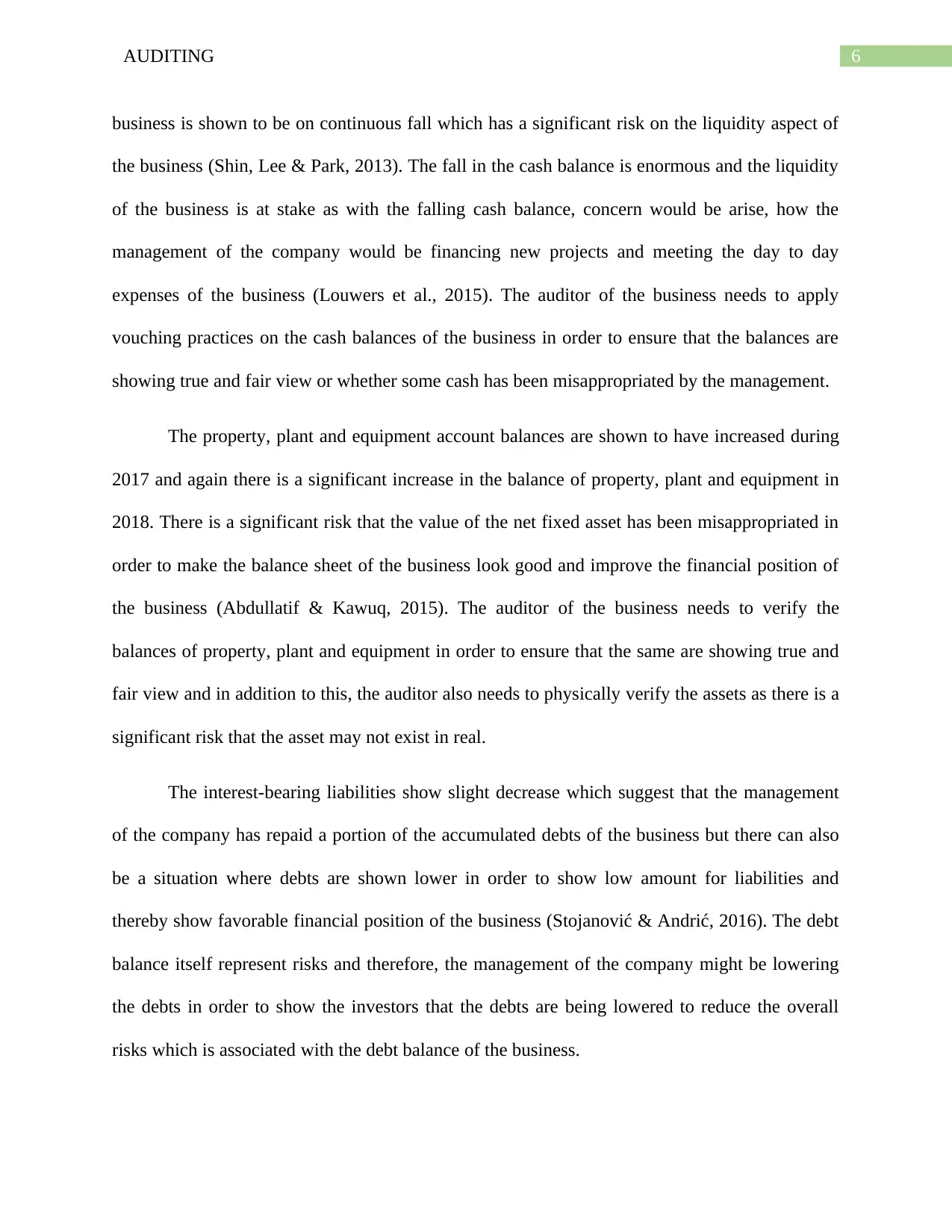
6AUDITING
business is shown to be on continuous fall which has a significant risk on the liquidity aspect of
the business (Shin, Lee & Park, 2013). The fall in the cash balance is enormous and the liquidity
of the business is at stake as with the falling cash balance, concern would be arise, how the
management of the company would be financing new projects and meeting the day to day
expenses of the business (Louwers et al., 2015). The auditor of the business needs to apply
vouching practices on the cash balances of the business in order to ensure that the balances are
showing true and fair view or whether some cash has been misappropriated by the management.
The property, plant and equipment account balances are shown to have increased during
2017 and again there is a significant increase in the balance of property, plant and equipment in
2018. There is a significant risk that the value of the net fixed asset has been misappropriated in
order to make the balance sheet of the business look good and improve the financial position of
the business (Abdullatif & Kawuq, 2015). The auditor of the business needs to verify the
balances of property, plant and equipment in order to ensure that the same are showing true and
fair view and in addition to this, the auditor also needs to physically verify the assets as there is a
significant risk that the asset may not exist in real.
The interest-bearing liabilities show slight decrease which suggest that the management
of the company has repaid a portion of the accumulated debts of the business but there can also
be a situation where debts are shown lower in order to show low amount for liabilities and
thereby show favorable financial position of the business (Stojanović & Andrić, 2016). The debt
balance itself represent risks and therefore, the management of the company might be lowering
the debts in order to show the investors that the debts are being lowered to reduce the overall
risks which is associated with the debt balance of the business.
business is shown to be on continuous fall which has a significant risk on the liquidity aspect of
the business (Shin, Lee & Park, 2013). The fall in the cash balance is enormous and the liquidity
of the business is at stake as with the falling cash balance, concern would be arise, how the
management of the company would be financing new projects and meeting the day to day
expenses of the business (Louwers et al., 2015). The auditor of the business needs to apply
vouching practices on the cash balances of the business in order to ensure that the balances are
showing true and fair view or whether some cash has been misappropriated by the management.
The property, plant and equipment account balances are shown to have increased during
2017 and again there is a significant increase in the balance of property, plant and equipment in
2018. There is a significant risk that the value of the net fixed asset has been misappropriated in
order to make the balance sheet of the business look good and improve the financial position of
the business (Abdullatif & Kawuq, 2015). The auditor of the business needs to verify the
balances of property, plant and equipment in order to ensure that the same are showing true and
fair view and in addition to this, the auditor also needs to physically verify the assets as there is a
significant risk that the asset may not exist in real.
The interest-bearing liabilities show slight decrease which suggest that the management
of the company has repaid a portion of the accumulated debts of the business but there can also
be a situation where debts are shown lower in order to show low amount for liabilities and
thereby show favorable financial position of the business (Stojanović & Andrić, 2016). The debt
balance itself represent risks and therefore, the management of the company might be lowering
the debts in order to show the investors that the debts are being lowered to reduce the overall
risks which is associated with the debt balance of the business.
Paraphrase This Document
Need a fresh take? Get an instant paraphrase of this document with our AI Paraphraser
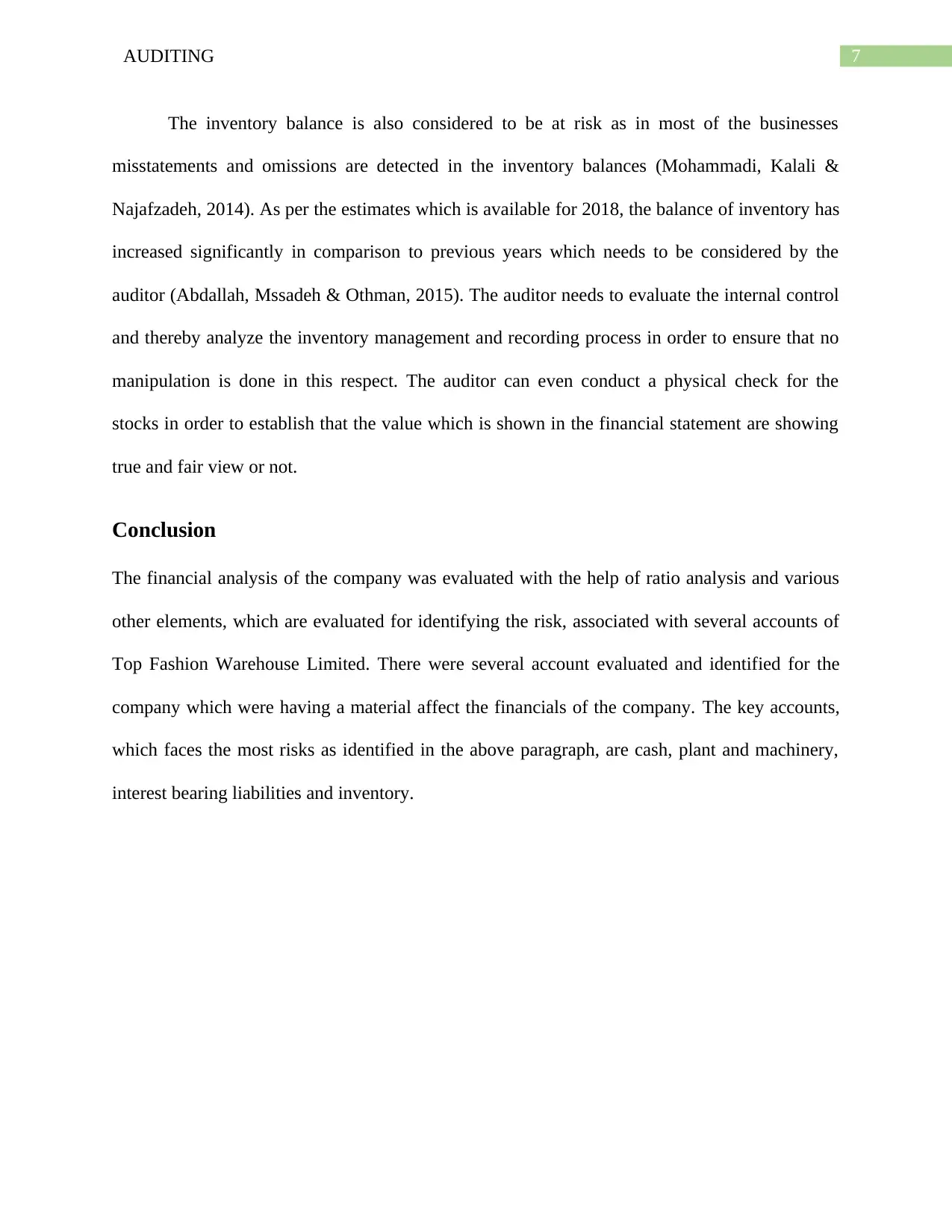
7AUDITING
The inventory balance is also considered to be at risk as in most of the businesses
misstatements and omissions are detected in the inventory balances (Mohammadi, Kalali &
Najafzadeh, 2014). As per the estimates which is available for 2018, the balance of inventory has
increased significantly in comparison to previous years which needs to be considered by the
auditor (Abdallah, Mssadeh & Othman, 2015). The auditor needs to evaluate the internal control
and thereby analyze the inventory management and recording process in order to ensure that no
manipulation is done in this respect. The auditor can even conduct a physical check for the
stocks in order to establish that the value which is shown in the financial statement are showing
true and fair view or not.
Conclusion
The financial analysis of the company was evaluated with the help of ratio analysis and various
other elements, which are evaluated for identifying the risk, associated with several accounts of
Top Fashion Warehouse Limited. There were several account evaluated and identified for the
company which were having a material affect the financials of the company. The key accounts,
which faces the most risks as identified in the above paragraph, are cash, plant and machinery,
interest bearing liabilities and inventory.
The inventory balance is also considered to be at risk as in most of the businesses
misstatements and omissions are detected in the inventory balances (Mohammadi, Kalali &
Najafzadeh, 2014). As per the estimates which is available for 2018, the balance of inventory has
increased significantly in comparison to previous years which needs to be considered by the
auditor (Abdallah, Mssadeh & Othman, 2015). The auditor needs to evaluate the internal control
and thereby analyze the inventory management and recording process in order to ensure that no
manipulation is done in this respect. The auditor can even conduct a physical check for the
stocks in order to establish that the value which is shown in the financial statement are showing
true and fair view or not.
Conclusion
The financial analysis of the company was evaluated with the help of ratio analysis and various
other elements, which are evaluated for identifying the risk, associated with several accounts of
Top Fashion Warehouse Limited. There were several account evaluated and identified for the
company which were having a material affect the financials of the company. The key accounts,
which faces the most risks as identified in the above paragraph, are cash, plant and machinery,
interest bearing liabilities and inventory.
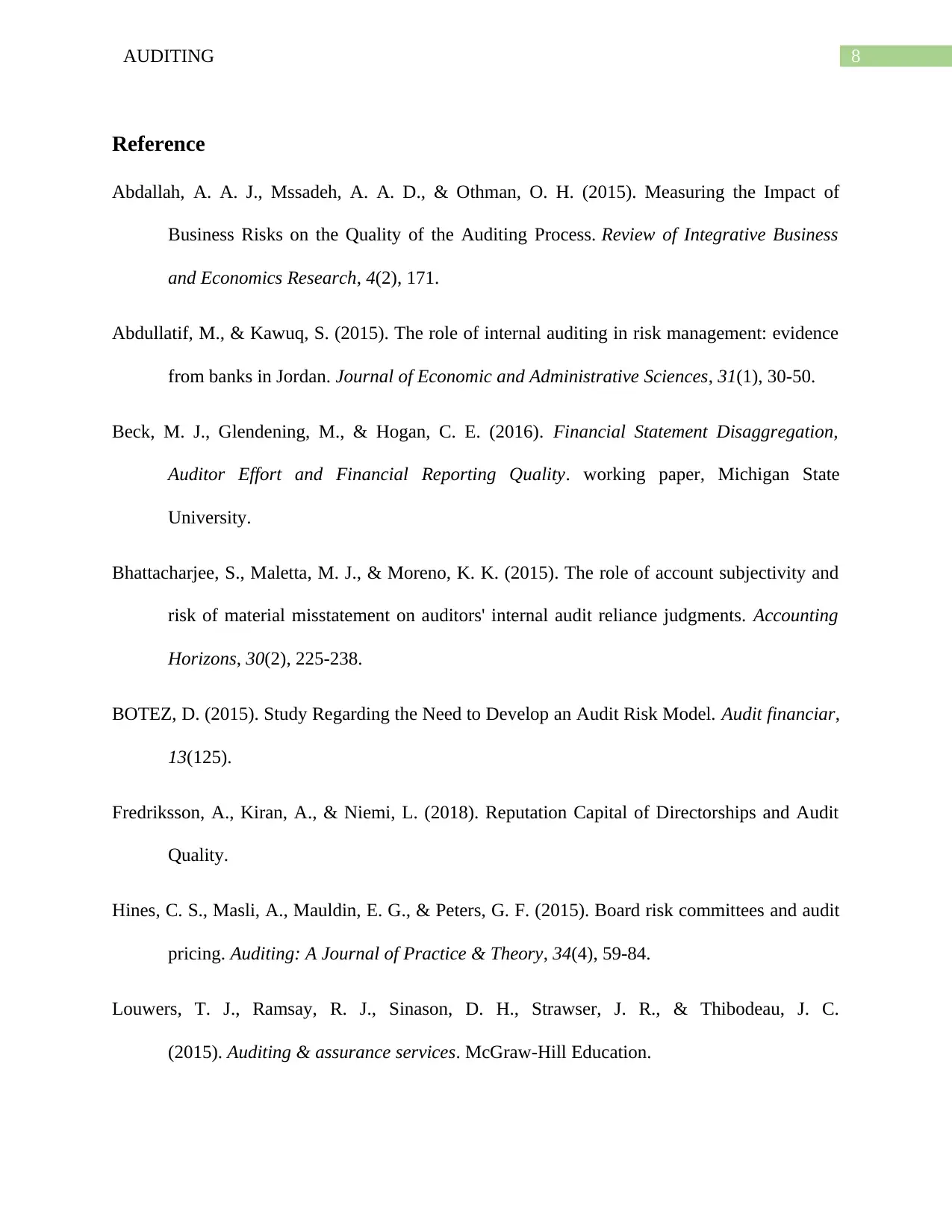
8AUDITING
Reference
Abdallah, A. A. J., Mssadeh, A. A. D., & Othman, O. H. (2015). Measuring the Impact of
Business Risks on the Quality of the Auditing Process. Review of Integrative Business
and Economics Research, 4(2), 171.
Abdullatif, M., & Kawuq, S. (2015). The role of internal auditing in risk management: evidence
from banks in Jordan. Journal of Economic and Administrative Sciences, 31(1), 30-50.
Beck, M. J., Glendening, M., & Hogan, C. E. (2016). Financial Statement Disaggregation,
Auditor Effort and Financial Reporting Quality. working paper, Michigan State
University.
Bhattacharjee, S., Maletta, M. J., & Moreno, K. K. (2015). The role of account subjectivity and
risk of material misstatement on auditors' internal audit reliance judgments. Accounting
Horizons, 30(2), 225-238.
BOTEZ, D. (2015). Study Regarding the Need to Develop an Audit Risk Model. Audit financiar,
13(125).
Fredriksson, A., Kiran, A., & Niemi, L. (2018). Reputation Capital of Directorships and Audit
Quality.
Hines, C. S., Masli, A., Mauldin, E. G., & Peters, G. F. (2015). Board risk committees and audit
pricing. Auditing: A Journal of Practice & Theory, 34(4), 59-84.
Louwers, T. J., Ramsay, R. J., Sinason, D. H., Strawser, J. R., & Thibodeau, J. C.
(2015). Auditing & assurance services. McGraw-Hill Education.
Reference
Abdallah, A. A. J., Mssadeh, A. A. D., & Othman, O. H. (2015). Measuring the Impact of
Business Risks on the Quality of the Auditing Process. Review of Integrative Business
and Economics Research, 4(2), 171.
Abdullatif, M., & Kawuq, S. (2015). The role of internal auditing in risk management: evidence
from banks in Jordan. Journal of Economic and Administrative Sciences, 31(1), 30-50.
Beck, M. J., Glendening, M., & Hogan, C. E. (2016). Financial Statement Disaggregation,
Auditor Effort and Financial Reporting Quality. working paper, Michigan State
University.
Bhattacharjee, S., Maletta, M. J., & Moreno, K. K. (2015). The role of account subjectivity and
risk of material misstatement on auditors' internal audit reliance judgments. Accounting
Horizons, 30(2), 225-238.
BOTEZ, D. (2015). Study Regarding the Need to Develop an Audit Risk Model. Audit financiar,
13(125).
Fredriksson, A., Kiran, A., & Niemi, L. (2018). Reputation Capital of Directorships and Audit
Quality.
Hines, C. S., Masli, A., Mauldin, E. G., & Peters, G. F. (2015). Board risk committees and audit
pricing. Auditing: A Journal of Practice & Theory, 34(4), 59-84.
Louwers, T. J., Ramsay, R. J., Sinason, D. H., Strawser, J. R., & Thibodeau, J. C.
(2015). Auditing & assurance services. McGraw-Hill Education.
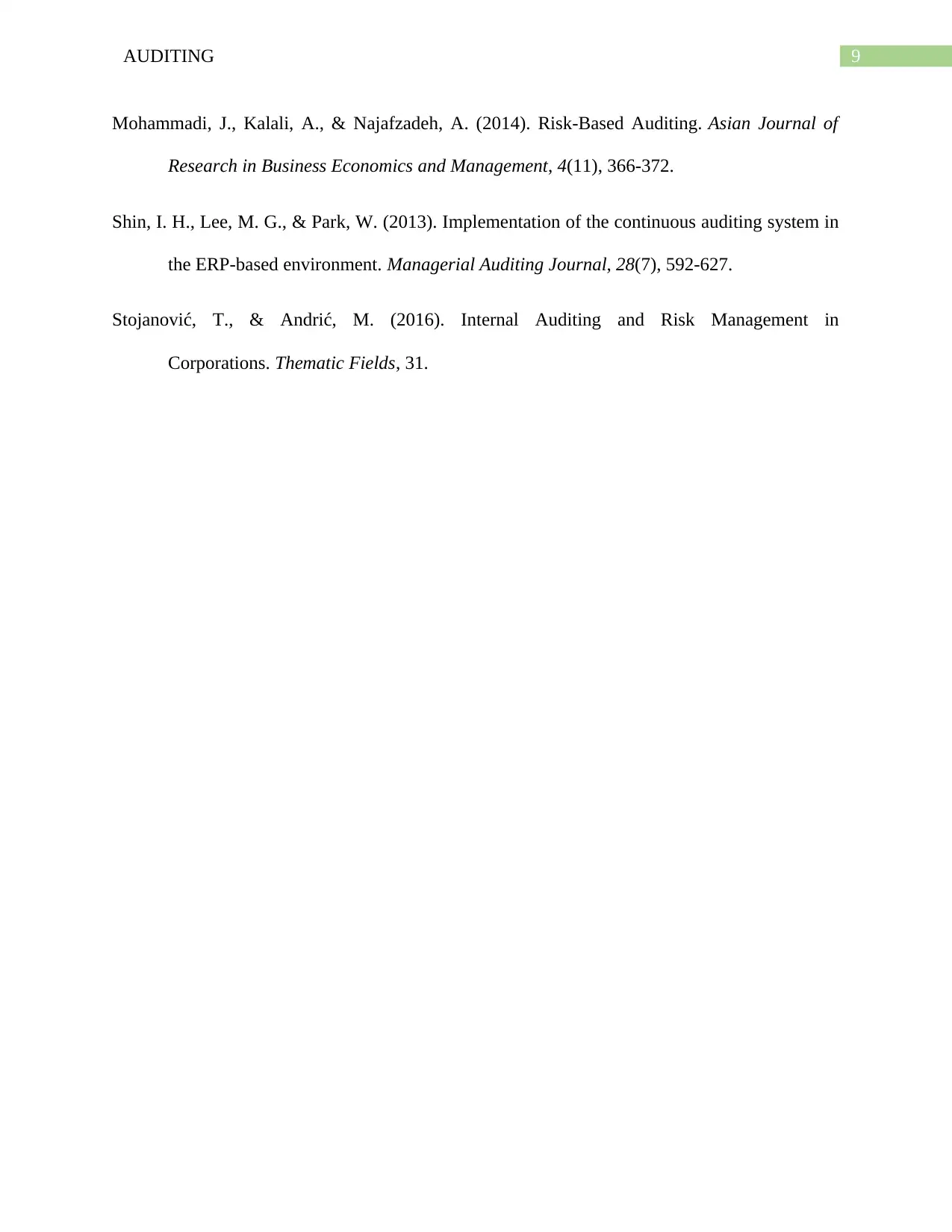
9AUDITING
Mohammadi, J., Kalali, A., & Najafzadeh, A. (2014). Risk-Based Auditing. Asian Journal of
Research in Business Economics and Management, 4(11), 366-372.
Shin, I. H., Lee, M. G., & Park, W. (2013). Implementation of the continuous auditing system in
the ERP-based environment. Managerial Auditing Journal, 28(7), 592-627.
Stojanović, T., & Andrić, M. (2016). Internal Auditing and Risk Management in
Corporations. Thematic Fields, 31.
Mohammadi, J., Kalali, A., & Najafzadeh, A. (2014). Risk-Based Auditing. Asian Journal of
Research in Business Economics and Management, 4(11), 366-372.
Shin, I. H., Lee, M. G., & Park, W. (2013). Implementation of the continuous auditing system in
the ERP-based environment. Managerial Auditing Journal, 28(7), 592-627.
Stojanović, T., & Andrić, M. (2016). Internal Auditing and Risk Management in
Corporations. Thematic Fields, 31.
Secure Best Marks with AI Grader
Need help grading? Try our AI Grader for instant feedback on your assignments.
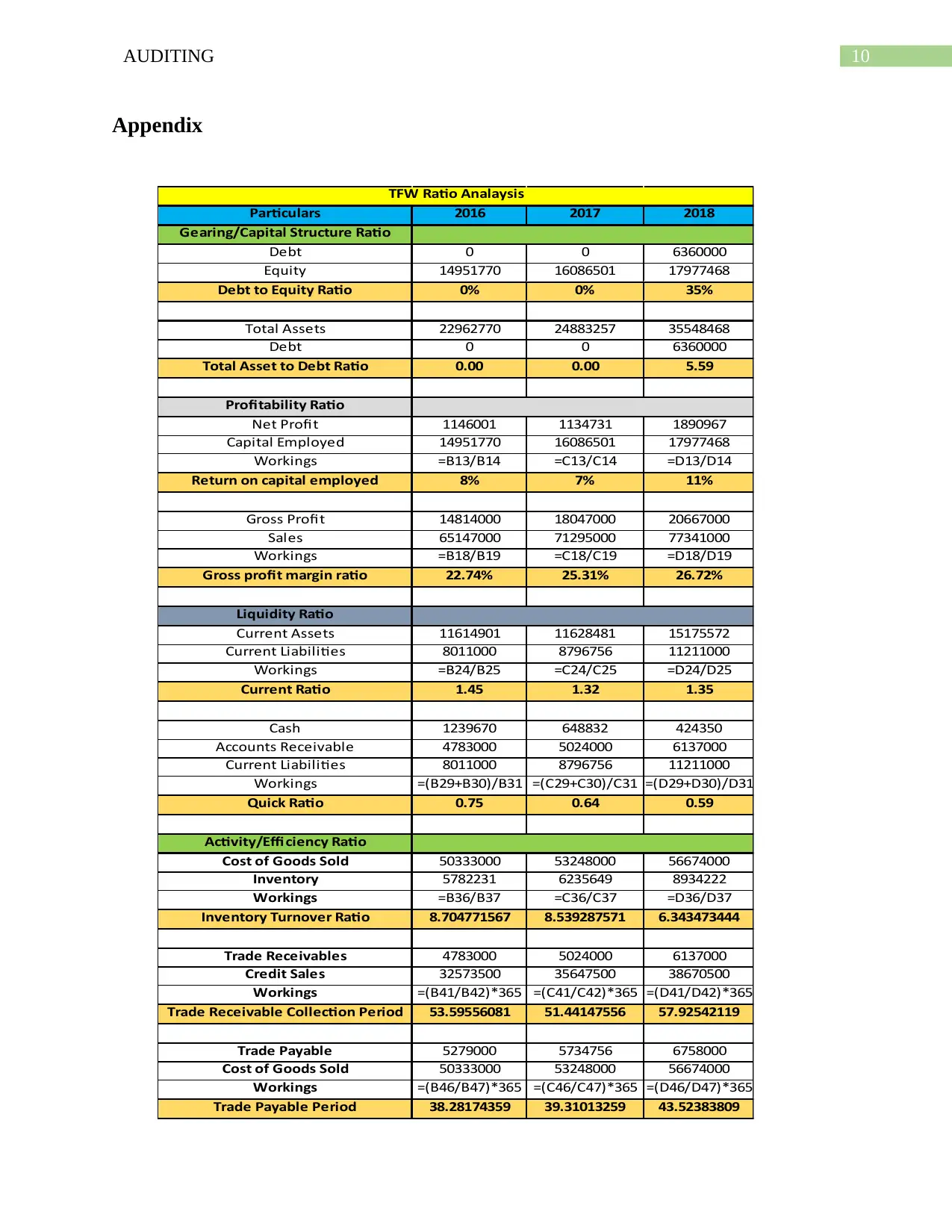
10AUDITING
Appendix
Particulars 2016 2017 2018
Gearing/Capital Structure Ratio
Debt 0 0 6360000
Equity 14951770 16086501 17977468
Debt to Equity Ratio 0% 0% 35%
Total Assets 22962770 24883257 35548468
Debt 0 0 6360000
Total Asset to Debt Ratio 0.00 0.00 5.59
Profitability Ratio
Net Profit 1146001 1134731 1890967
Capital Employed 14951770 16086501 17977468
Workings =B13/B14 =C13/C14 =D13/D14
Return on capital employed 8% 7% 11%
Gross Profit 14814000 18047000 20667000
Sales 65147000 71295000 77341000
Workings =B18/B19 =C18/C19 =D18/D19
Gross profit margin ratio 22.74% 25.31% 26.72%
Liquidity Ratio
Current Assets 11614901 11628481 15175572
Current Liabilities 8011000 8796756 11211000
Workings =B24/B25 =C24/C25 =D24/D25
Current Ratio 1.45 1.32 1.35
Cash 1239670 648832 424350
Accounts Receivable 4783000 5024000 6137000
Current Liabilities 8011000 8796756 11211000
Workings =(B29+B30)/B31 =(C29+C30)/C31 =(D29+D30)/D31
Quick Ratio 0.75 0.64 0.59
Activity/Efficiency Ratio
Cost of Goods Sold 50333000 53248000 56674000
Inventory 5782231 6235649 8934222
Workings =B36/B37 =C36/C37 =D36/D37
Inventory Turnover Ratio 8.704771567 8.539287571 6.343473444
Trade Receivables 4783000 5024000 6137000
Credit Sales 32573500 35647500 38670500
Workings =(B41/B42)*365 =(C41/C42)*365 =(D41/D42)*365
Trade Receivable Collection Period 53.59556081 51.44147556 57.92542119
Trade Payable 5279000 5734756 6758000
Cost of Goods Sold 50333000 53248000 56674000
Workings =(B46/B47)*365 =(C46/C47)*365 =(D46/D47)*365
Trade Payable Period 38.28174359 39.31013259 43.52383809
TFW Ratio Analaysis
Appendix
Particulars 2016 2017 2018
Gearing/Capital Structure Ratio
Debt 0 0 6360000
Equity 14951770 16086501 17977468
Debt to Equity Ratio 0% 0% 35%
Total Assets 22962770 24883257 35548468
Debt 0 0 6360000
Total Asset to Debt Ratio 0.00 0.00 5.59
Profitability Ratio
Net Profit 1146001 1134731 1890967
Capital Employed 14951770 16086501 17977468
Workings =B13/B14 =C13/C14 =D13/D14
Return on capital employed 8% 7% 11%
Gross Profit 14814000 18047000 20667000
Sales 65147000 71295000 77341000
Workings =B18/B19 =C18/C19 =D18/D19
Gross profit margin ratio 22.74% 25.31% 26.72%
Liquidity Ratio
Current Assets 11614901 11628481 15175572
Current Liabilities 8011000 8796756 11211000
Workings =B24/B25 =C24/C25 =D24/D25
Current Ratio 1.45 1.32 1.35
Cash 1239670 648832 424350
Accounts Receivable 4783000 5024000 6137000
Current Liabilities 8011000 8796756 11211000
Workings =(B29+B30)/B31 =(C29+C30)/C31 =(D29+D30)/D31
Quick Ratio 0.75 0.64 0.59
Activity/Efficiency Ratio
Cost of Goods Sold 50333000 53248000 56674000
Inventory 5782231 6235649 8934222
Workings =B36/B37 =C36/C37 =D36/D37
Inventory Turnover Ratio 8.704771567 8.539287571 6.343473444
Trade Receivables 4783000 5024000 6137000
Credit Sales 32573500 35647500 38670500
Workings =(B41/B42)*365 =(C41/C42)*365 =(D41/D42)*365
Trade Receivable Collection Period 53.59556081 51.44147556 57.92542119
Trade Payable 5279000 5734756 6758000
Cost of Goods Sold 50333000 53248000 56674000
Workings =(B46/B47)*365 =(C46/C47)*365 =(D46/D47)*365
Trade Payable Period 38.28174359 39.31013259 43.52383809
TFW Ratio Analaysis
1 out of 11
Related Documents
Your All-in-One AI-Powered Toolkit for Academic Success.
+13062052269
info@desklib.com
Available 24*7 on WhatsApp / Email
![[object Object]](/_next/static/media/star-bottom.7253800d.svg)
Unlock your academic potential
© 2024 | Zucol Services PVT LTD | All rights reserved.





